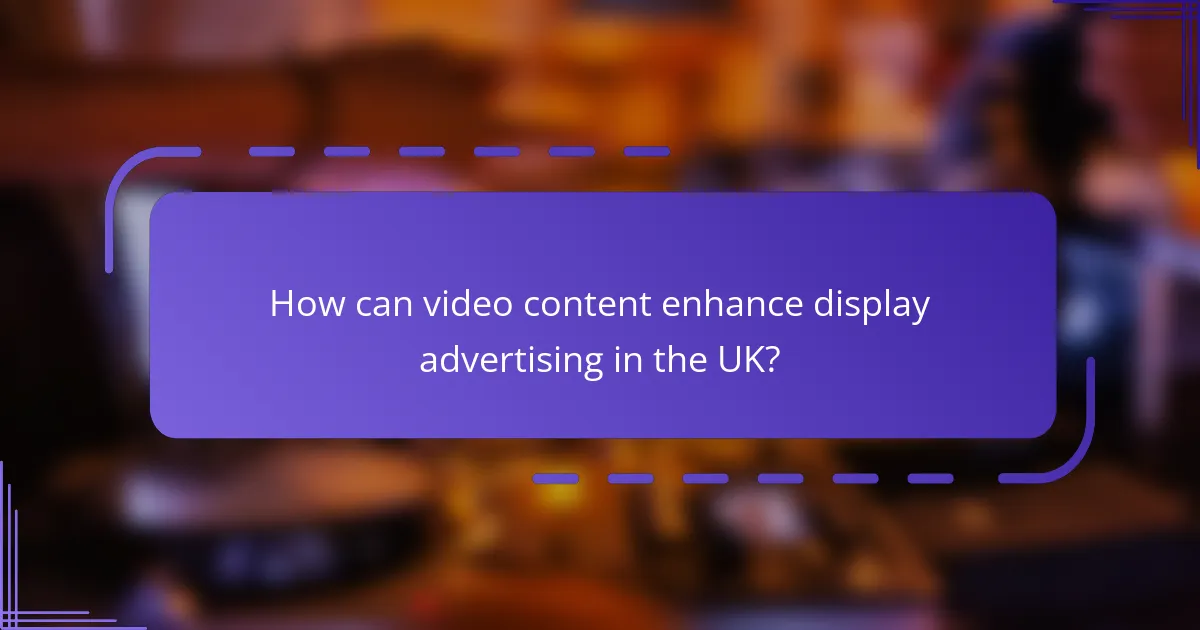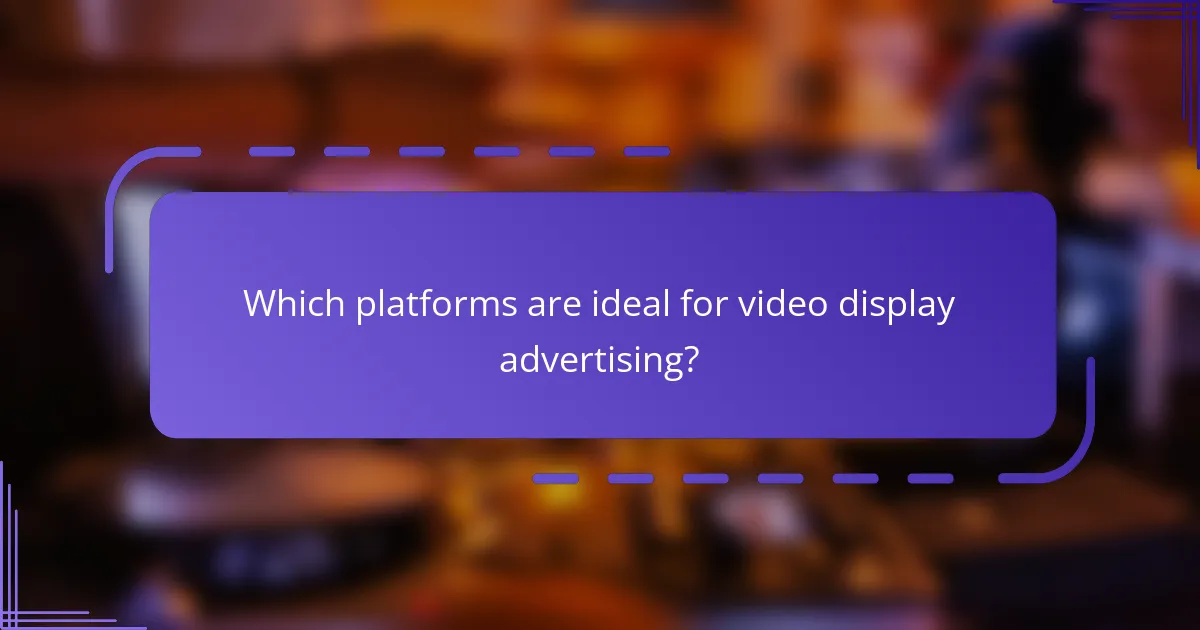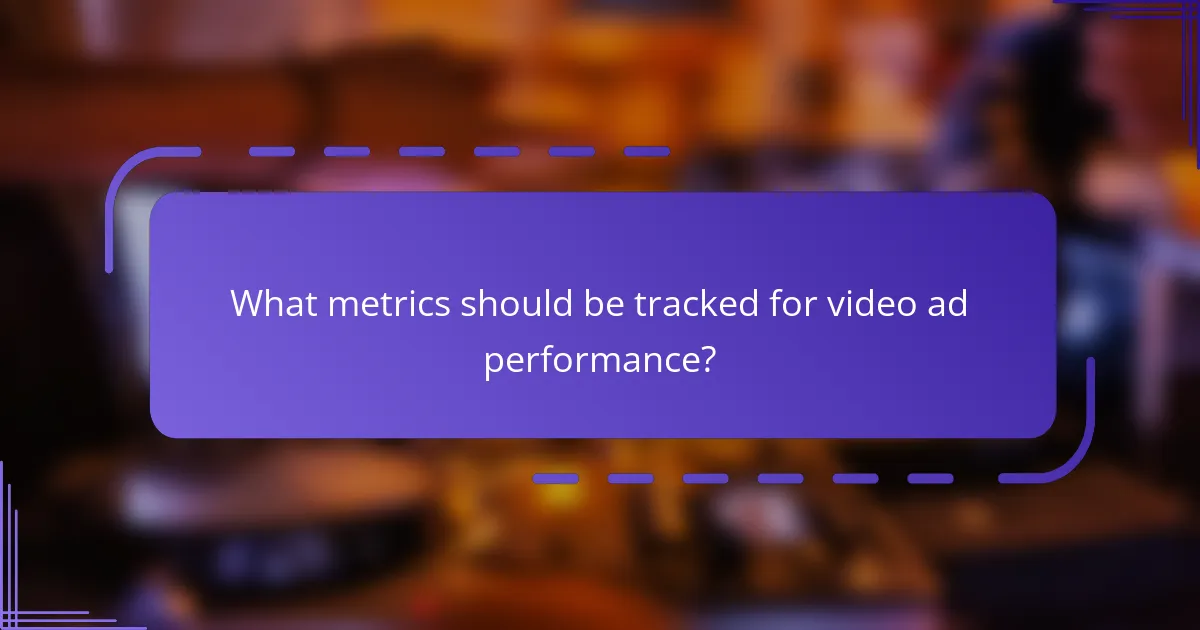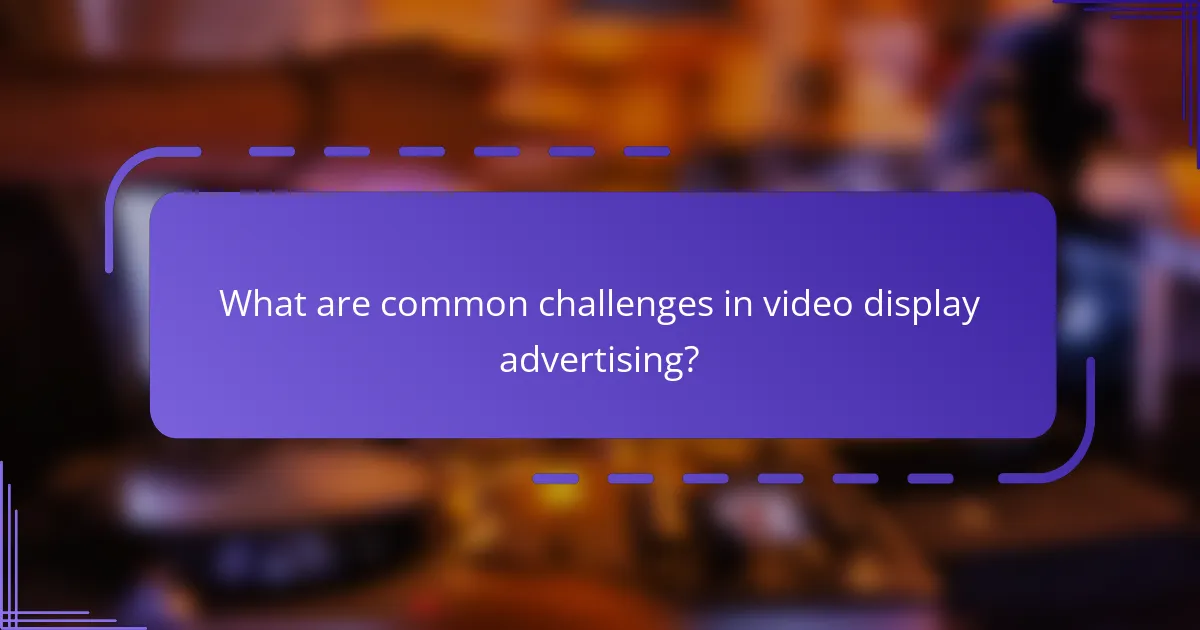Incorporating video content into display advertising can greatly enhance engagement and message retention, making it a powerful tool for brands. By prioritizing clarity, quality, and viewer interaction, advertisers can create compelling video ads that resonate with audiences. Leveraging platforms like Google Display Network, Facebook Ads, and Instagram Stories allows for effective outreach to diverse demographics through captivating video content.

How can video content enhance display advertising in the UK?
Video content can significantly enhance display advertising in the UK by capturing attention and conveying messages more effectively than static images. It engages viewers, making them more likely to interact with the ad and remember the brand.
Increased engagement rates
Video content tends to have higher engagement rates compared to traditional display ads. Viewers are more likely to watch a video ad to completion, especially if it is entertaining or informative. This increased engagement can lead to a more significant interaction with the brand.
To maximize engagement, keep videos short and focused, ideally under 30 seconds. Use captivating visuals and a clear call to action to encourage viewers to take the next step.
Improved brand recall
Using video in display advertising can enhance brand recall, as viewers are more likely to remember a brand after watching a video ad. The combination of audio and visual elements helps reinforce the brand message, making it stick in the audience’s mind.
Consider incorporating storytelling techniques in your video content, as narratives can create emotional connections that further boost recall. Aim for consistency in branding elements, such as logos and colors, to strengthen recognition.
Higher conversion rates
Video content can lead to higher conversion rates by providing potential customers with more information and a clearer understanding of the product or service. Demonstrations or testimonials in videos can effectively persuade viewers to make a purchase.
To improve conversion rates, include a strong call to action at the end of your video, directing viewers to your website or product page. Monitor performance metrics to refine your approach and ensure your video content resonates with your target audience.

What are the best practices for creating video ads?
Creating effective video ads involves focusing on clarity, quality, and engagement. By following best practices, advertisers can enhance viewer retention and drive action.
Short and concise messaging
Video ads should deliver a clear message quickly, ideally within the first few seconds. Aim for a concise script that communicates the core idea without unnecessary details.
Consider using a hook at the beginning to grab attention, followed by a straightforward explanation of the product or service. Keeping the messaging under 30 seconds is often effective for maintaining viewer interest.
High-quality visuals and sound
Investing in high-quality visuals and sound is essential for creating a professional impression. Poor audio or blurry images can detract from the message and lead to viewer disengagement.
Use high-definition video and clear audio to enhance the overall experience. Ensure that colors and graphics align with your brand identity to create a cohesive look.
Clear call-to-action
A strong call-to-action (CTA) is vital for guiding viewers on the next steps. Make sure the CTA is prominent and easy to understand, encouraging viewers to take action immediately.
Examples of effective CTAs include “Shop Now,” “Learn More,” or “Sign Up Today.” Position the CTA at the end of the video and consider repeating it during the ad to reinforce the message.

Which platforms are ideal for video display advertising?
Several platforms excel in video display advertising, each offering unique advantages. Google Display Network, Facebook Ads, and Instagram Stories are among the most effective options for reaching diverse audiences through engaging video content.
Google Display Network
The Google Display Network (GDN) allows advertisers to showcase video ads across millions of websites and apps. This platform supports various ad formats, including in-stream and out-stream videos, which can be targeted based on user behavior, demographics, and interests.
When using GDN, consider the importance of optimizing your video length; shorter videos (around 15 seconds) often perform better. Utilize A/B testing to determine which video content resonates most with your audience, and monitor performance metrics to refine your strategy.
Facebook Ads
Facebook Ads provides a robust platform for video display advertising, enabling brands to reach users in their news feed, stories, and in-stream placements. The platform’s targeting capabilities allow advertisers to reach specific demographics and interests, enhancing engagement rates.
For effective campaigns, keep videos concise and impactful, ideally under 30 seconds. Utilize captions since many users watch videos without sound. Regularly analyze engagement metrics such as views, shares, and click-through rates to adjust your approach as needed.
Instagram Stories
Instagram Stories are a popular format for video display advertising, offering full-screen, immersive experiences that capture user attention. Ads can appear between user stories, making them highly visible and engaging.
To maximize effectiveness, create visually appealing content that conveys your message quickly, ideally within 15 seconds. Incorporate interactive elements like polls or questions to boost engagement. Track performance through Instagram Insights to refine future campaigns based on viewer interactions and retention rates.

What metrics should be tracked for video ad performance?
To evaluate video ad performance effectively, focus on key metrics such as view-through rate, click-through rate, and engagement metrics. These indicators provide insights into how well your video content resonates with the audience and drives desired actions.
View-through rate
View-through rate (VTR) measures the percentage of users who viewed your video ad to completion compared to the total number of impressions. A higher VTR indicates that your content is engaging and relevant to viewers. Aim for a VTR of at least 30% to ensure your message is being absorbed.
To improve VTR, consider optimizing video length, as shorter videos often retain viewer attention better. Additionally, ensure the initial few seconds are captivating to encourage viewers to watch through to the end.
Click-through rate
Click-through rate (CTR) gauges the percentage of viewers who clicked on your ad after watching it. A strong CTR typically ranges from 1% to 5%, depending on the industry and ad placement. This metric is crucial for assessing how effectively your video drives traffic to your website or landing page.
To enhance CTR, include clear calls-to-action (CTAs) within your video. Experiment with different placements and designs for CTAs to see what resonates best with your audience.
Engagement metrics
Engagement metrics encompass various indicators such as likes, shares, comments, and average watch time. These metrics reflect how viewers interact with your video content and can signal its overall effectiveness. High engagement rates suggest that your audience finds the content valuable and worth sharing.
To boost engagement, create content that encourages viewer interaction, such as asking questions or prompting discussions. Monitor these metrics regularly to adapt your strategy based on audience preferences and behaviors.

What are common challenges in video display advertising?
Video display advertising faces several challenges that can hinder its effectiveness. Key issues include ad fatigue, technical problems, and difficulties in audience targeting, all of which can impact viewer engagement and campaign success.
Ad fatigue
Ad fatigue occurs when audiences become overly familiar with a video ad, leading to decreased engagement and effectiveness. This can happen quickly, often within a few weeks of a campaign launch, especially if the same audience is repeatedly exposed to the same content.
To combat ad fatigue, consider rotating your video ads frequently and introducing new creative elements. Testing different formats, such as shorter clips or interactive content, can also help maintain viewer interest.
Technical issues
Technical issues can significantly disrupt video display advertising campaigns. Problems such as slow loading times, poor video quality, or compatibility issues across devices can lead to viewer frustration and abandonment.
To minimize technical difficulties, ensure your video files are optimized for various platforms and devices. Regularly test your ads in different environments and consider using adaptive streaming technologies to enhance user experience.
Audience targeting difficulties
Effective audience targeting is crucial for the success of video display advertising, yet it can be challenging. Misalignment between ad content and audience interests can result in low engagement rates and wasted ad spend.
Utilize data analytics to refine your targeting strategies. Segment your audience based on demographics, interests, and behaviors, and tailor your video content accordingly. Regularly review and adjust your targeting parameters to improve campaign performance.

How does video length affect viewer retention?
Video length significantly impacts viewer retention, with shorter videos generally holding attention better. Research indicates that videos lasting under two minutes tend to retain a higher percentage of viewers compared to longer formats.
Optimal length for engagement
The optimal length for engaging video content typically falls between 15 seconds and two minutes. Shorter videos, around 15 to 30 seconds, are ideal for quick messaging and social media platforms, while videos of one to two minutes can provide more in-depth information without losing viewer interest.
Consider the platform when determining video length. For instance, platforms like Instagram and TikTok favor brief clips, while YouTube allows for longer content that can delve deeper into topics. Tailoring video length to the audience’s expectations on each platform can enhance engagement rates.
To maximize viewer retention, focus on delivering your key message within the first few seconds. Avoid unnecessary introductions and get straight to the point, ensuring that the content is engaging and relevant to the audience’s interests.
